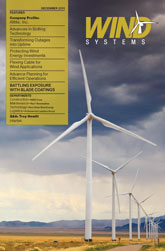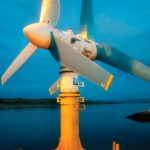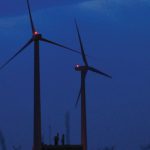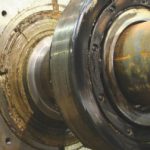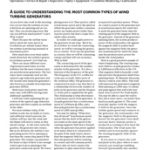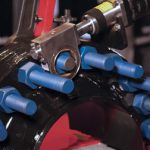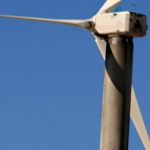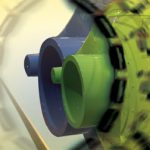It is no secret that the wind energy industry in the United States has experienced strong growth in recent years as one of the most popular renewable power sources. In fact, according to American Wind Energy Association (AWEA), the U.S. wind industry has added over 35 percent of all the new power generating capacity over the last four years. This is second only to natural gas. As new developers enter this growing space, it is important to consider the variety of risks they are exposed to during the process of building and operating a wind farm.
In addition to managing their risk exposures, developers need to ensure that they have a solid understanding of the various types of insurance coverages that will help protect their investment. Whether the wind farm will have multiple turbines and sites, or a single turbine is added to a commercial location, a developer should look for an insurance carrier that can provide coverage to help them manage risk throughout the lifecycle of the wind farm operation.
Developing and running a successful wind farm requires attention to detail, and every step from site selection to operations and maintenance brings a new challenge. Through the multi-step process of setting up a wind farm there are risk management best practices and proper coverages that developers should consider to minimize exposures while building a successful operation.
Site Selection and Land Assessment
When selecting a site, conducting a feasibility study is a critical first step for developers to better understand the potential energy output that could be produced at a given location. To help make these assessments, meteorological (met) towers are installed on the land for extended periods, often one to two years, in order to assess the site’s wind resource.
The identification and management of risk surrounding the use of these valuable assets is paramount as the project moves forward. Met towers may be subject to a variety of exposures including weather-related elements (wind, ice and snow, lightning) or fire, collapse, and vandalism. Insurance protection, such as a scheduled property floater or a builder’s risk or installation policy, can help protect owners and ensure that towers are adequately covered should damage occur.
In addition to reviewing the exposures for the physical property, the potential liability exposures should be analyzed. Updates to insurance coverage may be needed depending on how the existing property will be modified for the operations of a wind farm. Once a site is purchased or leased developers need to be aware of potential land exposures, whether it be vacant land set aside for the wind farm construction or property where a wind turbine may be located in close proximity to other structures or dwellings. An insurance agent who is well versed in providing coverage for wind farms, and understands exposures associated with wind turbines, can be a great resource for more detailed information on issues associated with general liability coverage, which can protect owners in case people are injured on site or when non-owned property is damaged. As the site is being assessed for wind energy potential, a developer should also consider other factors in site selection:
• An environmental analysis of the proposed location helps determine how the development and operation of a wind farm may impact the environment such as noise, wildlife, plants and soil, endangered species, and the flying patterns for migratory birds.
• Flood and earthquake potential should be analyzed for the site under consideration. Building a farm in a designated flood zone or an area prone to earthquakes can have a long-term significant effect on turbines.
• The accessibility of the site should be considered. Farms are often located in remote areas or even mountainous terrain, so owners and operators need to ensure that adequate roadway infrastructure is in place to get heavy equipment and supplies to the project site, and to provide accessibility for workers and emergency responders.
Contractual Requirements
After site selection and land assessment has occurred, a myriad of contracts should be in place before construction begins, starting with the construction contract. Another document important to consider is the Power Purchase Agreement, or PPA, which is the agreement between the developer/owner and an energy buyer, such as a public utility. The PPA outlines expectations about the price and production for the energy being sold.
In addition to detailing what the buyer will pay for the promised production, the contract also contains other important information such as insurance coverage requirements, and may have clauses limiting the liability of both parties or even a waiver of subrogation. Assignment of financial responsibility for differing types of required insurance coverage and other clauses are important to consider, as each contract is unique. How the contract is structured may impact long-term revenue.
Developers should be aware of other contracts as well, such as an Interconnection Agreement, which specifies the terms and conditions under which the wind farm’s system can be connected to the utility grid. Financing agreements are often contingent upon the successful placement of insurance and bonds, so management oversight in this area is critical. It’s also important to involve your legal counsel in all your contract matters.
Securing Permits
Permitting is a vital step associated with installing wind turbines. This process can be complicated and may affect timing, location, and costs of the project. This step often moves forward in earnest when it is clear the environmental review process is moving ahead favorably. Local zoning ordinances vary greatly and change as this industry evolves. Be aware of local zoning ordinances in order to secure permitting, from assessments through construction and operation.
Turbine Procurement
Securing the type of turbines most appropriate for the site is the next step where developers should consider their potential exposures. The turbine sales agreement will outline contractual requirements, and the experience of all parties involved should be reviewed. For example, when selecting a manufacturer, ensure they have a strong track record. Working with manufacturers that meet and exceed industry standards can positively impact the reliability and life of the equipment as well as reduce future risks. Additionally, consider the replacement time and availability of component parts along with the ability to get the parts to the job site.
The transportation of wind turbines adds another layer of complexity to the process of setting up a wind farm. Due to the enormity of the turbines—including the nacelle, blades and tower sections—transporting them can be a logistical challenge. A developer should ensure proper protection is in place to protect against potential damage to the turbine or other property during the transportation process. Work with shippers who are experienced in specialized hauling, and wind energy in particular, as they should understand the challenges associated with moving this type of cargo. Since components of turbines may come from overseas, developers need to be actively involved with their insurance agent to ensure they have the property and casualty coverage in place both for transporting turbines and their components stateside and overseas.
Construction Contracting
One of the most difficult and dangerous elements of wind farm development is the installation of the towers and turbines. Developers should work closely with construction contractors at the outset to make sure the appropriate risk management processes and procedures are in place. The relationship with an experienced general contractor with a positive reputation for safety management and education of employees and sub-contractors is critical.
As construction starts to move ahead, this is another good point in the process for developers to again review their insurance, contractual, and bonding requirements, and work closely with an agent who understands the best coverages, risk management, and claims services to meet the needs of the project. Complex projects like this may need additional coverages for builder’s risk, workers compensation, general liability, auto liability, and an umbrella policy, among others, as the farm is being built. Reviewing insurance protection throughout wind farm construction will serve to help mitigate and protect against a multitude of potential risks.
Operations and Maintenance
While construction of the farm is underway, wind farm developers will also look to ensure that the operations and maintenance (O&M) contracts and plans are under development. These contracts play a large role in ensuring that the output and anticipated life of the turbine meet expectations. Protection of the assets and performance of routine and planned maintenance are primary functions of the O&M team. The developer and owner need to consider how local conditions can affect the turbines. Gearbox components, tower metal, fasteners, and blades are subject to wear and tear, and this—along with other signs of fatigue—can make a significant difference in the safety and production of each turbine.
Protecting the Business
Now that the wind farm is nearing a fully operational state, wind farm developers should look to ensure they have business interruption coverage in place in the event that the farm may have to shutter its operations, even temporarily. For example, wind farm developers may take advantage of federal and tax incentives to help make the wind farm’s operation financially manageable. If business is interrupted due to a fire or even a major weather-related event, the cash flows from these grants could also cease, which could adversely affect the business. Business interruption coverage helps with the loss of income during that time frame. Purchasing insurance to protect the business against the event of business interruption can provide the developer much needed financial security.
Choosing the Best Coverage
A wide range of insurance products and services are available to wind farm developers. Here are some guidelines that developers can follow to help when making insurance purchases for their unique needs:
• Lifecycle coverage: Can your insurer provide coverage as the farm evolves through each stage? Having one insurer who can cover all aspects of wind farm development can help simplify and strengthen the insurance process. Using different insurers could leave some grey areas or even gaps in coverage.
• Growing with the business: Wind farm developers may seek new opportunities to expand their business operations, whether it is to increase power output at a given location or start new construction projects. Will your insurer cover wind farms of all sizes so that the relationship can grow as the business expands?
• Reliable experts: Working with an insurer with expertise in the renewable energy industry can have significant pay-offs for wind farm developers. This encompasses having underwriters who can assess risk accurately based on their extensive industry knowledge and provide appropriate coverage for competitive premiums, risk control advisors who can deliver guidance on best practices and claim professionals who understand the contractual language and industry processes to help mitigate losses.
As the shift to renewable energy and wind farms continues to gain momentum, those looking to join the growing industry will be faced with many decisions. Among the most important is the plan a new developer creates to minimize exposure and ensure that they are well protected from unexpected loss by having the right contracts and insurance coverages in place. Working with an informed insurance agent and insurance carrier with deep knowledge of the renewable energy market can help their business grow and prosper.



















